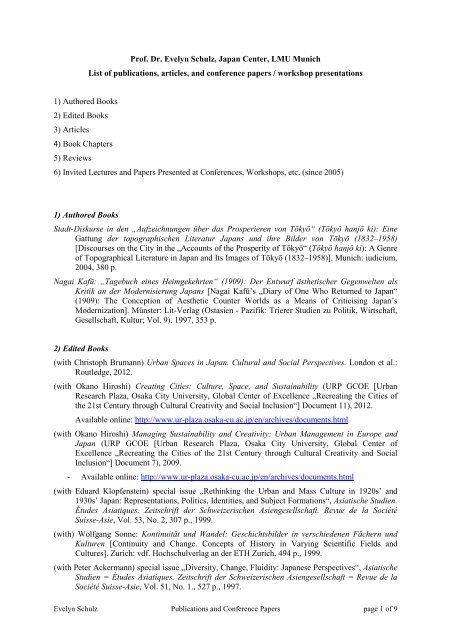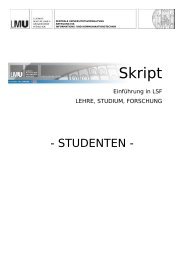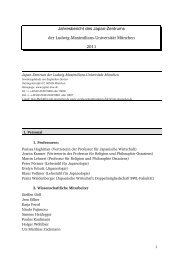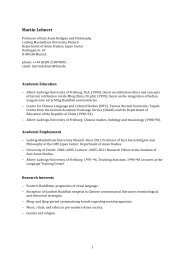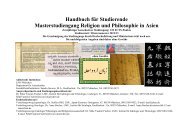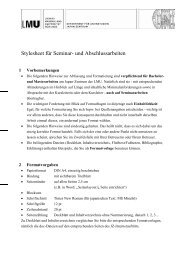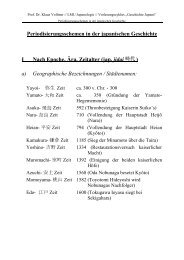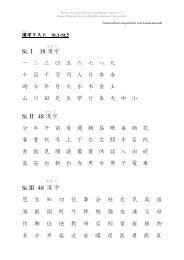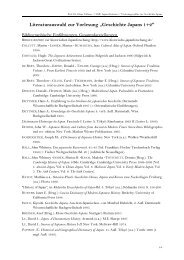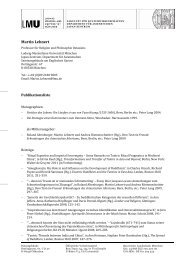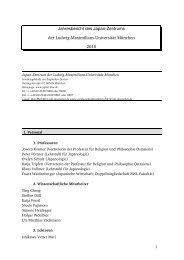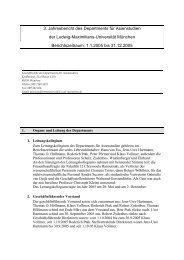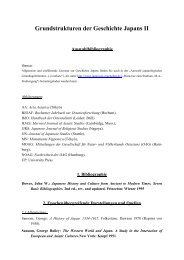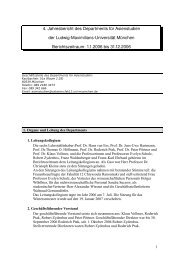Prof. Dr. Evelyn Schulz, Japan-Zentrum, LMU München
Prof. Dr. Evelyn Schulz, Japan-Zentrum, LMU München
Prof. Dr. Evelyn Schulz, Japan-Zentrum, LMU München
You also want an ePaper? Increase the reach of your titles
YUMPU automatically turns print PDFs into web optimized ePapers that Google loves.
<strong>Prof</strong>. <strong>Dr</strong>. <strong>Evelyn</strong> <strong>Schulz</strong>, <strong>Japan</strong> Center, <strong>LMU</strong> Munich<br />
List of publications, articles, and conference papers / workshop presentations<br />
1) Authored Books<br />
2) Edited Books<br />
3) Articles<br />
4) Book Chapters<br />
5) Reviews<br />
6) Invited Lectures and Papers Presented at Conferences, Workshops, etc. (since 2005)<br />
1) Authored Books<br />
Stadt-Diskurse in den „Aufzeichnungen über das Prosperieren von Tōkyō“ (Tōkyō hanjō ki): Eine<br />
Gattung der topographischen Literatur <strong>Japan</strong>s und ihre Bilder von Tōkyō (1832–1958)<br />
[Discourses on the City in the „Accounts of the Prosperity of Tōkyō“ (Tōkyō hanjō ki): A Genre<br />
of Topographical Literature in <strong>Japan</strong> and Its Images of Tōkyō (1832–1958)]. Munich: iudicium,<br />
2004, 380 p.<br />
Nagai Kafū: „Tagebuch eines Heimgekehrten“ (1909): Der Entwurf ästhetischer Gegenwelten als<br />
Kritik an der Modernisierung <strong>Japan</strong>s [Nagai Kafū’s „Diary of One Who Returned to <strong>Japan</strong>“<br />
(1909): The Conception of Aesthetic Counter Worlds as a Means of Criticising <strong>Japan</strong>’s<br />
Modernization]. Münster: Lit-Verlag (Ostasien - Pazifik: Trierer Studien zu Politik, Wirtschaft,<br />
Gesellschaft, Kultur; Vol. 9), 1997, 353 p.<br />
2) Edited Books<br />
(with Christoph Brumann) Urban Spaces in <strong>Japan</strong>. Cultural and Social Perspectives. London et al.:<br />
Routledge, 2012.<br />
(with Okano Hiroshi) Creating Cities: Culture, Space, and Sustainability (URP GCOE [Urban<br />
Research Plaza, Osaka City University, Global Center of Excellence „Recreating the Cities of<br />
the 21st Century through Cultural Creativity and Social Inclusion“] Document 11), 2012.<br />
Available online: http://www.ur-plaza.osaka-cu.ac.jp/en/archives/documents.html<br />
(with Okano Hiroshi) Managing Sustainability and Creativity: Urban Management in Europe and<br />
<strong>Japan</strong> (URP GCOE [Urban Research Plaza, Osaka City University, Global Center of<br />
Excellence „Recreating the Cities of the 21st Century through Cultural Creativity and Social<br />
Inclusion“] Document 7), 2009.<br />
- Available online: http://www.ur-plaza.osaka-cu.ac.jp/en/archives/documents.html<br />
(with Eduard Klopfenstein) special issue „Rethinking the Urban and Mass Culture in 1920s’ and<br />
1930s’ <strong>Japan</strong>: Representations, Politics, Identities, and Subject Formations“, Asiatische Studien.<br />
Études Asiatiques. Zeitschrift der Schweizerischen Asiengesellschaft. Revue de la Société<br />
Suisse-Asie, Vol. 53, No. 2, 307 p., 1999.<br />
(with) Wolfgang Sonne: Kontinuität und Wandel: Geschichtsbilder in verschiedenen Fächern und<br />
Kulturen [Continuity and Change. Concepts of History in Varying Scientific Fields and<br />
Cultures]. Zurich: vdf. Hochschulverlag an der ETH Zurich, 494 p., 1999.<br />
(with Peter Ackermann) special issue „Diversity, Change, Fluidity: <strong>Japan</strong>ese Perspectives“, Asiatische<br />
Studien = Études Asiatiques. Zeitschrift der Schweizerischen Asiengesellschaft = Revue de la<br />
Société Suisse-Asie, Vol. 51, No. 1., 527 p., 1997.<br />
<strong>Evelyn</strong> <strong>Schulz</strong> Publications and Conference Papers page 1 of 9
3) Articles<br />
“<strong>Japan</strong>, March 11, 2011, and Its Aftermath: Reflections on Issues of Environmental Ethics and<br />
Society”, Poligrafi (Slovenia), proceedings of the conference Living with Consequences:<br />
Environmental Ethics and Society, Department of Philosophy, Faculty of Humanities Koper,<br />
Science and Research Centre of Koper, University of Primorska, Koper, Slovenia, October 14-<br />
15, 2011), Vol. 69/70, 2013, pp. 101–132.<br />
“Nagai Kafū’s Reflections on Urban Beauty in Hiyorigeta: Reappraising Tokyo’s Back Alleys and<br />
Waterways”, Review of Asian and Pacific Studies (Center for Asian and Pacific Studies, Seikei<br />
University, Tokyo), Nr. 36, 2011, pp. 139–164.<br />
『 忙 しい 街 とのんびりした 街 の 融 合 ~ 文 学 からみた 都 市 再 生 のヒント』 (Fusions of Busy and<br />
Relaxed Quarters: Hints Concerning Urban Revitalization as Revealed in Literary Works), 『 異<br />
文 化 研 究 』 = Journal of Cross-Cultural Studies (Yamaguchi University, <strong>Japan</strong>) Vol. 5<br />
(March), pp. 75–83.<br />
„Trends of Revitalizing Central City Peripheries in Tokyo“, disP – The Planning Review, Nr. 181,<br />
(special issue „Metropolitan Peripheries“), 2010, pp. 30–33.<br />
『 東 京 におけるスローシティとファストシティの 同 時 性 : 多 様 性 のある 都 市 空 間 の 魅 力 』<br />
(The Synchronism of the Slow City and Fast City in Tokyo: The Appeal of a Polymorphic<br />
Urban Space), published by Kokusai Asakusagaku purojekuto, Meiji University, Tokyo<br />
[http://www.tokyoedoradio.org/Project/downloads/downloads.html], 2009.<br />
„Tsuji Hitonari: Warten auf die Sonne“ [Tsuji Hitonari: Waiting for the Sun], Asiaintercultura,<br />
http://www.asiaintercultura.de/asia/deutsch/magazin.html (pp. 4–6), 2008.<br />
„The Revival of the Roji in Modern <strong>Japan</strong>: The Role of Indigenous Urban Structures in the Discourse<br />
of the Urban“, Review of Asian and Pacific Studies (Center for Asian and Pacific Studies, Seikei<br />
University, Tokyo), Nr. 32, 2007, pp. 1–23.<br />
„Killer, Krimis, Kommissare: Über die Geschichte und Popularität der Kriminalliteratur in <strong>Japan</strong>“<br />
[Killers, Mysteries and Inspectors: On the History and Popularity of Crime Fiction in <strong>Japan</strong>],<br />
Hefte für ostasiatische Literatur, Nr. 41, 2007, pp. 102–120.<br />
„Megalopolis Tokyo – Die Rückeroberung des städtischen Raums durch den Flâneur“ [Megalopolis<br />
Tokyo – The Reconquest of Urban Space by the Flâneur] (Goethe-Institute, Online-Dossier<br />
„Urban Landscapes“, http://www.goethe.de/kue/arc/dos/dos/sls/sfo/de1566336.htm), 2006.<br />
„Auf schmalen Hintergassen (roji) zu Fuß durch Tōkyō: Literarische Anleitungen zur Erkundung der<br />
historischen und kulturellen Vielfalt kleinräumiger Altstadtquartiere“ [Walking through Tokyos<br />
narrow backstreets (roji). Literary Guides to Explore the Historical and Cultural Diversity of<br />
Small Scale Neighbourhoods], Minikomi, Nr. 72, 2006, pp. 5–15.<br />
„Rediscovering the Roji: Strategies of Integrating Marginalized Spaces into the Mainstream of Urban<br />
Discourse”, Proceedings of the International Conference on East Asian Architectural Culture<br />
Kyoto 2006: Reassessing East Asia in the Light of Urban and Architectural History, Vol. 2,<br />
2006, pp. 225–234.<br />
„Performing Urban Memory: The Sumidagawa as Mnemonic Site in Kimura Shōhachi’s Tōkyō hanjō<br />
ki (Report about the Prosperity of Tōkyō; 1958)“, Asiatische Studien = Études Asiatiques.<br />
Zeitschrift der Schweizerischen Asiengesellschaft = Revue de la Société Suisse-Asie, Vol. 58,<br />
No. 3, 2005, pp. 667–686.<br />
„Der Berg in der Stadt – Ausblicke vom Atagoyama auf Edo“ [The Mountain in the City: Views from<br />
the Atagoyama over Edo], Asiatische Studien = Études Asiatiques. Zeitschrift der<br />
Schweizerischen Asiengesellschaft = Revue de la Société Suisse-Asie (special issue „Meer und<br />
Berge in der <strong>Japan</strong>ischen Kultur. Europäische <strong>Japan</strong>-Diskurse III und IV“; ed. by Eduard<br />
Klopfenstein and Simone Müller), Vol. 57, No. 3, 2004, pp. 577–599.<br />
<strong>Evelyn</strong> <strong>Schulz</strong> Publications and Conference Papers page 2 of 9
„Narratives of Counter-Modernity: Urban Spaces and Mnemonic Sites in the Tōkyō hanjō ki“,<br />
European Journal of East Asian Studies (special issue „Incipient Mass Cultures“), 2.1, 2003,<br />
pp. 117–151.<br />
„Ideen zur Stadtreform um 1900 in <strong>Japan</strong>: Kōda Rohans Traktat ‚Die Hauptstadt der Nation’“ [Ideas<br />
on Urban Reform in <strong>Japan</strong> around 1900: Kōda Rohan’s Treatise „One Nation’s Capital“],<br />
Bochumer Jahrbuch für Ostasienforschung (special issue „Rückschau und Ausblicke. Utopien<br />
und Zukunftsvisionen in und zu Ostasien“), Vol. 24, 2000, pp. 153–180.<br />
„Stadt in <strong>Japan</strong> – eine interdisziplinäre Herausforderung“ [The City in <strong>Japan</strong> – An Interdisciplinary<br />
Challenge], Duisburger Arbeitspapiere Ostasienwissenschaften (special issue „Grenzgänge:<br />
Quo vadis sozialwissenschaftliche <strong>Japan</strong>forschung? Methoden- und Zukunftsfragen“), Vol. 20,<br />
1999, pp. 25–35.<br />
„Mapping the City and Tracing out the Past: Images of Tōkyō in ‚Accounts of Prosperity’ (hanjōki),<br />
1900–1930“, Asiatische Studien = Études Asiatiques. Zeitschrift der Schweizerischen<br />
Asiengesellschaft = Revue de la Société Suisse-Asie (special issue „Rethinking the Urban and<br />
Mass Culture in 1920s’ and 1930s’ <strong>Japan</strong>: Representations, Politics, Identities, and Subject<br />
Formations“, ed. by <strong>Evelyn</strong> <strong>Schulz</strong> and Eduard Klopfenstein), Vol. 53, No. 2, 1999, pp. 255–<br />
291.<br />
„Foreword“, Asiatische Studien = Études Asiatiques. Zeitschrift der Schweizerischen Asiengesellschaft<br />
= Revue de la Société Suisse-Asie (special issue „Rethinking the Urban and Mass Culture in<br />
1920s’ and 1930s’ <strong>Japan</strong>: Representations, Politics, Identities, and Subject Formations“, ed. by<br />
<strong>Evelyn</strong> <strong>Schulz</strong> and Eduard Klopfenstein), Vol. 53, No. 2, 1999, pp. 143–145.<br />
„The City as a Space of Change: Images of Tōkyō in Kōda Rohan’s Ikkoku no shuto (One Nation’s<br />
Capital; 1899)”, Asiatische Studien = Études Asiatiques. Zeitschrift der Schweizerischen<br />
Asiengesellschaft = Revue de la Société Suisse-Asie (special issue „Diversity, Change, Fluidity:<br />
<strong>Japan</strong>ese Perspectives“, ed. by Peter Ackermann and <strong>Evelyn</strong> <strong>Schulz</strong>), Vol. 51, No. 1, 1997, pp.<br />
293–318.<br />
„A Note on Changing Concepts of History” (with Christoph Langemann), in: Asiatische Studien =<br />
Études Asiatiques. Zeitschrift der Schweizerischen Asiengesellschaft = Revue de la Société<br />
Suisse-Asie (special issue „Diversity, Change, Fluidity: <strong>Japan</strong>ese Perspectives“, ed. by Peter<br />
Ackermann and <strong>Evelyn</strong> <strong>Schulz</strong>), Vol. 51, No. 1, 1997, pp. 19–22.<br />
„Foreword“ (with Peter Ackermann), Asiatische Studien = Études Asiatiques. Zeitschrift der<br />
Schweizerischen Asiengesellschaft = Revue de la Société Suisse-Asie (special issue „Diversity,<br />
Change, Fluidity: <strong>Japan</strong>ese Perspectives“, ed. by Peter Ackermann and <strong>Evelyn</strong> <strong>Schulz</strong>), Vol. 51,<br />
No. 1, 1997, pp. 11–14.<br />
„Das ‚Ende der Stadt’ und die ‚Stadt der Zukunft’: Kōda Rohans Überlegungen zu Tōkyō um 1900“<br />
[The „End of the City“ and the „City of the Future“: Kōda Rohan’s Thoughts on Tōkyō around<br />
1900], Swiss-<strong>Japan</strong>ese Chamber of Commerce (Ed.). Journal, No. 1, 1997, pp. 54–57.<br />
„Die Stadt in der Literatur am Beispiel von Nagai Kafūs Fukagawa no uta (Lied von Fukagawa;<br />
1909)“ [The City in Literature: Nagai Kafū’s Fukagawa no uta (Song of Fukagawa) as<br />
example], Asiatische Studien = Études Asiatiques. Zeitschrift der Schweizerischen<br />
Asiengesellschaft = Revue de la Société Suisse-Asie, Vol. 51, No. 4, 1997, pp. 1167–1174.<br />
„Nagai Kafū – Seine Reise in den Westen und seine Kritik an der Modernisierung <strong>Japan</strong>s“ [Nagai<br />
Kafū – His Journey to the West and his Criticism of <strong>Japan</strong>’s Modernization], <strong>Japan</strong>studien:<br />
Jahrbuch des Deutschen Instituts für <strong>Japan</strong>studien der Philipp-Franz-von-Siebold-Stiftung, Vol.<br />
5. Munich: iudicium, 1994, pp. 343–388.<br />
„Nagai Kafūs Konzept einer kulturellen Modernisierung <strong>Japan</strong>s und seine Idee einer nationalen<br />
Musik“ [Nagai Kafū’s Concept of <strong>Japan</strong>’s Cultural Modernization and his Idea of a National<br />
Music], Asiatische Studien = Études Asiatiques. Zeitschrift der Schweizerischen<br />
Asiengesellschaft = Revue de la Société Suisse-Asie (Sondernummer: Referate des 9.<br />
deutschsprachigen <strong>Japan</strong>ologentags in Zürich), Vol. 48, No. 1, 1994, pp. 102–114.<br />
<strong>Evelyn</strong> <strong>Schulz</strong> Publications and Conference Papers page 3 of 9
4) Book Chapters<br />
in print<br />
„Jenseits der Moderne“, in: Hildner, Claudia (ed.): Future Living: Gemeinschaftliches Wohnen in<br />
<strong>Japan</strong>. Basel: Birkhäuser, 2013, pp. 11–27. // englisch edition: „Beyond modernism“, in:<br />
Hildner, Claudia (ed.): Future Living: Community Living in <strong>Japan</strong>. Basel: Birkhäuser, 2013, pp.<br />
11–27.<br />
Published<br />
„My Tokyo / Watashi no Tokyo“, in: MYTO (MY Tokyo). A Literary-Photographic Portrait of Tokyo.<br />
Stuttgart: edition esefeld & traub, 2013, pp. 216–220.<br />
„Introduction,“ (with Christoph Brumann and Christian Dimmer), in: Christoph Brumann and <strong>Evelyn</strong><br />
<strong>Schulz</strong> (eds.): Urban Spaces in <strong>Japan</strong>. Social and Cultural Perspectives. London et al.:<br />
Routledge, 2012, pp. 1–14.<br />
“Walking the City: Spatial and Temporal Configurations of the Urban Spectator in Writings on<br />
Tokyo”, in: Christoph Brumann and <strong>Evelyn</strong> <strong>Schulz</strong> (eds.): Urban Spaces in <strong>Japan</strong>. Social and<br />
Cultural Perspectives. London et al.: Routledge, 2012, pp. 184–202.<br />
„Revitalizing Tokyo’s Back Alleys as Areas of Cultural Sustainability and a Decelerated Lifestyle“,<br />
in: <strong>Evelyn</strong> <strong>Schulz</strong> and Okano Hiroshi (eds.): Creating Cities: Culture, Space, and Sustainability<br />
(URP GCOE [Urban Research Plaza, Osaka City University, Global Center of Excellence<br />
„Recreating the Cities of the 21st Century through Cultural Creativity and Social Inclusion“]<br />
Document 11), 2012, pp. 34–44.<br />
„Introduction“, in: <strong>Evelyn</strong> <strong>Schulz</strong> and Okano Hiroshi (eds.): Creating Cities: Culture, Space, and<br />
Sustainability (URP GCOE [Urban Research Plaza, Osaka City University, Global Center of<br />
Excellence „Recreating the Cities of the 21st Century through Cultural Creativity and Social<br />
Inclusion“] Document 11), 2012, pp. 4–6.<br />
明 治 大 学 国 際 日 本 学 部 編 : ドイツの 日 本 研 究 を 担 う 大 学 ・ 研 究 機 関 ・ 学 会 『[ニッポン 学 ]<br />
の 現 在 – GENJIからクールジャパンへ』( 角 川 学 芸 出 版 , 2008), pp. 245–257.<br />
„Researching the roji – Issues of materials and methods from the point of view of cultural history and<br />
literary studies“ in Radovic, Darko (2008). Another Tokyo. Places and Practices of Urban<br />
Resistance. Tokyo: cSUR, University of Tokyo, ichii Studio, 2008, pp. 18–19.<br />
„Die ‚Renaissance der Stadt’ (toshi saisei) und die Wiederentdeckung der Hintergassen (roji) –<br />
Aspekte der Literatur und Kultur des Flanierens in <strong>Japan</strong>“ [The ‚Renaissance of the City’ (toshi<br />
saisei) and the Rediscovery of the Roji – Aspects of the Literature and Culture of Urban<br />
Strolling in <strong>Japan</strong>], in: Krusche, Jürgen und <strong>Japan</strong>isch-Deutsches <strong>Zentrum</strong> Berlin (Hg.). Der<br />
Raum der Stadt: Raumtheorien zwischen Architektur, Soziologie, Kunst und Philosophie in<br />
<strong>Japan</strong> und im Westen. Marburg: Jonas Verlag, 2008, pp. 74–88.<br />
„The Past in Tōkyō’s Future: Kōda Rohan’s Thoughts on Urban Reform and the New Citizen“, in:<br />
Fievé, Nicolas, and Paul Waley (eds.). <strong>Japan</strong>ese Capitals in Historical Perspective: Power,<br />
Memory and Place in Kyoto, Edo and Tokyo. London: Curzon Press, 2003, pp. 283–308.<br />
„Ansichten von Tōkyō: Das Tōkyō hanjō ki (Aufzeichnungen über das Prosperieren von Tōkyō, 1958)<br />
von Kimura Shōhachi“ [Views of Tōkyō: Kimura Shōhachi’s Tōkyō hanjō ki (Account of the<br />
Prosperity of Tōkyō, 1958)], in: Seifert, Wolfgang, and Asa-Bettina Wuthenow (eds.). Anbauten<br />
Umbauten. Beiträge zur <strong>Japan</strong>forschung. Festgabe für Wolfgang Schamoni zum 60. Geburtstag<br />
von seinen Schülern, Mitarbeitern und Kollegen. Munich: iudicium, 2003, pp. 333–350.<br />
„Erinnerte Orte: Bilder von Tōkyō im Dai Tōkyō hanjō ki (Aufzeichnungen über das Prosperieren von<br />
Groß-Tōkyō; 1927)“ [Places of Memory: Images of Tōkyō in the Dai Tōkyō hanjō ki (Accounts<br />
of the Prosperity of Greater Tōkyō; 1927)], in: Gössmann, Hilaria, and Andreas Mrugalla (eds.).<br />
<strong>Evelyn</strong> <strong>Schulz</strong> Publications and Conference Papers page 4 of 9
11. Deutschsprachiger <strong>Japan</strong>ologentag in Trier 1999. Vol. II: Sprache, Literatur, Kunst,<br />
Populärkultur/Medien, Informationstechnik. Münster: Lit-Verlag (Ostasien - Pazifik: Trierer<br />
Studien zu Politik, Wirtschaft, Gesellschaft, Kultur; Vol. 14), 2001, pp. 249–261.<br />
„Die Restitution des Stillstands: Ästhetische Gegenwelten der japanischen Moderne“ [The Restitution<br />
of Cessation: Aesthetic Counter Worlds of <strong>Japan</strong>’s Modern Age], in: <strong>Schulz</strong>, <strong>Evelyn</strong>, and<br />
Wolfgang Sonne (eds.). Kontinuität und Wandel: Geschichtsbilder in verschiedenen Fächern<br />
und Kulturen. Zürich: vdf. Hochschulverlag an der ETH Zürich, 1999, pp. 333–377.<br />
„Vorwort“ [Foreword; with Wolfgang Sonne], in: <strong>Schulz</strong>, <strong>Evelyn</strong>, and Wolfgang Sonne (eds.).<br />
Kontinuität und Wandel: Geschichtsbilder in verschiedenen Fächern und Kulturen [Continuity<br />
and Change. Concepts of History in Varying Scientific Fields and Cultures]. Zurich: vdf.<br />
Hochschulverlag an der ETH Zürich, 1999, pp. 7–15.<br />
„Die Sehnsucht nach der verlorenen Ganzheit: Welt und Gegenwelt bei Nagai Kafū und Natsume<br />
Sōseki“ [The Longing for the Lost Unity: World and Counter World in the Works of Nagai<br />
Kafū and Natsume Sōseki; with Christoph Langemann], in: <strong>Japan</strong>lesebuch III, Tübingen:<br />
Claudia Gehrke Verlag, 1998, pp. 121–146.<br />
„Sinologie und Krieg: Ein ‚Brief zur Kultur Chinas’ von Takeda Taijun“ [Sinology and War: A ‚Letter<br />
on China’s Culture’ by Takeda Taijun], in: Findeisen, Raoul D., and Robert H. Gassman (eds.).<br />
Autumn Floods. Essays in Honour of Marián Galik (Schweizer Asiatische Studien:<br />
Monographien, Vol. 30), 1998, pp. 614–629.<br />
„Ikkoku no shuto (Die Hauptstadt des Landes) von Kōda Rohan: Stadtkritik zwischen Zukunftsvision<br />
und konfuzianischem Denken“ [Kōda Rohan’s Ikkoku no shuto (One Nation’s Capital):<br />
Criticism of the City between Vision of the Future and Confucian Thought], in: Pörtner, Peter et<br />
al. (ed.). Referate des 10. Deutschsprachigen <strong>Japan</strong>ologentags, München, 9.–12. Oktober 1996,<br />
CD-Rom, 1997, pp. 25–33.<br />
„Edo, Tōkyō und Paris – gewollte und gewordene Moderne um 1909 aus der Sicht des Autors Nagai<br />
Kafū“ [Edo, Tōkyō and Paris – How it was Wished and how it Became: Modernity at 1909<br />
from the Point of View of the Writer Nagai Kafū], in: Gewollt oder geworden? – Planung,<br />
Zufall, natürliche Entwicklung in <strong>Japan</strong>. Referate des 4. <strong>Japan</strong>ologentags der OAG in Tokyo,<br />
17./18. März 1994. Munich: iudicium, 1996, pp. 83–100.<br />
4) Reviews<br />
„Murder Most Modern. Detective Fiction and <strong>Japan</strong>ese Culture. By Sari Kawana. University of<br />
Minnesota Press, 2003, and Purloined Letters: Cultural Borrowing and <strong>Japan</strong>ese Crime<br />
Literature, 1868-1937. By Mark Silver. University of Hawai’i Press, 2008”, Monumenta<br />
Nipponica, Vol. 64:2 (Autumn) (2009), pp. 46–52.<br />
„Ungleichheit in der global city Tōkyō: Aktuelle sozialräumliche Entwicklungen im Spannungsfeld von<br />
Globalisierung und lokalen Sonderbedingungen. By Ralph Lützeler. Iudicium, Munich, 2008”,<br />
Journal for <strong>Japan</strong>ese Studies, 36:1 (2010), pp. 179–182.<br />
„Giftmischerinnen, Vagabundinnen und Erotomaninnen. Eine Literatur- und Mediengeschichte<br />
krimineller und devianter Frauentypen im modernen <strong>Japan</strong>“ (Review of: Christine L. Marran:<br />
Poison Woman. Figuring Female Transgression in Modern <strong>Japan</strong>ese Culture. Minneapolis:<br />
University of Minnesota Press 2007.); In: IASLonline [17.02.2009]; URL:<br />
<br />
La modernité à l’horizon: La culture populaire dans le Japon des années vingt. Edited by Jean-<br />
Jacques Tschudin and Claude Hamon. Arles: Édition Philippe Picquier (2004), in: European<br />
Journal of East Asian Studies, 4.2, 2005, pp. 317–321.<br />
„Nagai Kafū. Tagebuch. Das Jahr 1937. Übersetzt von Barbara Yoshida-Krafft, mit Erläuterungen<br />
von Reinhold Grinda. Munich: iudicium, 2003“, in: Hefte für Ostasiatische Literatur (HOL),<br />
Vol. 36 (May 2004), pp. 153–159.<br />
<strong>Evelyn</strong> <strong>Schulz</strong> Publications and Conference Papers page 5 of 9
Stadtplanung in <strong>Japan</strong>: Geschichte – Recht – Praxis – Theorie [City Planning in <strong>Japan</strong>: History – Law<br />
– Practice – Theory] (Dortmund: Dortmunder Vertrieb für Bau- und Planungsliteratur), 2000,<br />
616 pp., by Uta Hohn, in: <strong>Japan</strong>studien. Jahrbuch des Deutschen Instituts für <strong>Japan</strong>studien der<br />
Philip Franz von Siebold Stiftung, Vol. 13 (special issue „Dwelling in <strong>Japan</strong>“) (2001), pp. 455–<br />
462.<br />
5) Invited lectures and papers presented at conferences, workshops, etc. (since 2005)<br />
“<strong>Japan</strong>ese entanglements with global flows of Fin de siècle aestheticism and urban counter<br />
modernities: The example of Nagai Kafū and his essay Hiyorigeta (Fair Weather Clogs, 1914)”,<br />
panel <strong>Japan</strong>ese Cities in Global Context: Urban Life and Public Space, Urban History<br />
Association Conference (topic: The Cosmopolitan Metropolis), New York, October 25-28,<br />
2012.<br />
„Global flows and transnational entanglements in local discourses on Tokyo: Nagai Kafū’s reflections<br />
on urban aesthetics in Hiyorigeta (Fair-weather clogs, 1914)”, Literature and Globalization.<br />
Representations, Transformations, Interventions, <strong>LMU</strong> Munich, June 14-16, 2012.<br />
„Einführung in das Leben und Werk von Mori Ōgai“ [Introduction to the Work and Life of Mori<br />
Ōgai], Ethnologischer Salon, Völkerkundemuseum München, April 27, 2012.<br />
„Reappraising Tokyo’s Back Alleys and Waterways: Aspects of the Current Discourse on the Slow<br />
City in <strong>Japan</strong>“, paper presented at the panel <strong>Japan</strong>ese Cities in Global Networks, Annual<br />
Meeting of the Association of American Geographers (AAG), New York, February 24-28,<br />
2012.<br />
„Urban Imaginaries and Urban Aesthetics in Nagai Kafū’s Writings on Post-Meiji Tokyo“,<br />
Conference and Workshop <strong>Japan</strong>ese Cities in Global Context, Bryn Mawr College,<br />
Philadelphia, February 25-26, 2012.<br />
„Die Bedeutungswandlungen des Begriffs roji („Hintergasse“): Die Genese von einem ästhetischen<br />
Raumkonzept in der modernen Literatur zu einem Modell einer alternativen Urbanität“<br />
[Semantic Changes of the Word Roji (Back Alley): Its Genesis from an Aesthetic Spatial<br />
Concept in Modern Literature to a Model of an Alternative Urbanity], Begriffsgeschichten aus<br />
den Ostasienwissenschaften: Mechanismen der Begriffsprägung und -etablierung im<br />
<strong>Japan</strong>ischen, Chinesischen und Koreanischen, November 18-20, 2011, Bonn University.<br />
„Nagai Kafūs Reflexionen über die Atmosphäre und Ästhetik städtischer Räume: Zeitgenössische und<br />
gegenwärtige Aspekte der Neuentdeckung und Revitalisierung von Tokios Hintergassen und<br />
Wasserwegen“ [Nagai Kafū’s Reflections on the Atmosphere and Aesthetics of Urban Spaces:<br />
Atmosphäre und Ästhetik städtischer Räume: Contemporary and Present-day Aspects of the<br />
Rediscovery and Revitalizaton of Tokyo’s Back-Alleys and Waterways], <strong>Japan</strong>ologie, J.W.<br />
Goethe-Universität Frankfurt, November 17, 2011.<br />
„<strong>Japan</strong>bilder zwischen Fakten und Klischees: Historische und kulturelle Hintergründe“ [Images of<br />
<strong>Japan</strong> between Facts and Clichés: Historical and Cultural Backgrounds], Japonismus –<br />
Inszenierungen einer Sehnsucht, Evangelische Akademie Tutzing, Germany, November 4,<br />
2011.<br />
“<strong>Japan</strong>, March 11, 2011, and Its Aftermath: Reflections on Issues of Environmental Ethics and<br />
Society”, Living with Consequences: Environmental Ethics and Society, Department of<br />
Philosophy, Faculty of Humanities Koper, Science and Research Centre of Koper, University of<br />
Primorska, Koper, Slovenia, October 14-15, 2011.<br />
„Die Verletzbarkeit der Megacity Tokyo“ [The Vulnerability of the Megacity Tokyo], <strong>Japan</strong>ologie,<br />
J.W. Goethe-Universität Frankfurt, July 7, 2011.<br />
<strong>Evelyn</strong> <strong>Schulz</strong> Publications and Conference Papers page 6 of 9
„Megalopolis Tokio: Ethnologische Reflexionen einer Augenzeugin“, [Megalopolis Tokyo:<br />
Ethnological Reflexions of an Eye Witness], Ethnologischer Salon, Völkerkundemuseum<br />
München, April 29, 2011.<br />
„Nagai Kafū’s Strategy of Rewriting Tokyo: Literary Representations of Roji Areas as Real and<br />
Symbolic Urban Spaces“, Kanda University of Foreign Studies, Tokyo, November 19, 2010.<br />
『 東 西 の 景 観 論 ・ 都 市 論 の 蓄 積 としての 日 和 下 駄 』 [in <strong>Japan</strong>ese; Hiyorigeta as an<br />
Accumulation of Eastern and Western Discourses on Landscape and the City], Seikei<br />
University, Tokyo, November 17, 2010.<br />
『 忙 しい 街 とのんびりした 街 の 融 合 ~ 文 学 からみた 都 市 再 生 のヒント』 [Fusions of Busy and<br />
Relaxed Quarters: Aspects of Urban Revitalization from the Point of View of Literatur],<br />
Yamaguchi University, <strong>Japan</strong>, November 12, 2010.<br />
„Der Diskurs über die roji („Hintergasse“) in der Moderne und Gegenwart <strong>Japan</strong>s: Literarische<br />
Repräsentationen kleinräumiger Stadtviertel als reale und symbolische Räume“ [The Discourse<br />
on Roji (Back Alleys) in Modern and Present Day <strong>Japan</strong>: Literary Representations of Small-<br />
Scale Quarters as Real and Symbolic Spaces], workshop of the Study Group Vormoderne<br />
Literatur <strong>Japan</strong>s [Premodern Literature of <strong>Japan</strong>], Institute of <strong>Japan</strong>ology, University of<br />
Heidelberg, June 18-20, 2010.<br />
„Geschichte und Gegenwart von Ueno – Tokyo: Das Viertel Yanaka und seine heutige Relevanz als<br />
Slow Zone“ [Past and Present History of Ueno – Tokyo: Yanaka District and Ist Contemporary<br />
Meaning as „Slow Zone“], Hochschule für Technik, Wirtschaft und Kultur Leipzig, April 15,<br />
2010.<br />
„Revitalizing Tokyo’s Back Alleys as Areas of Cultural Sustainability and Decelerated<br />
Lifestyle“,Creating Cities: Culture, Space, and Sustainability, The City, Culture and Society<br />
(CCS) Conference, Munich University, February 25–27, 2010.<br />
『 水 辺 とタワーの 空 間 としての 浅 草 -スカイツリーと 浅 草 の 新 しい 可 能 性 -』[in <strong>Japan</strong>ese;<br />
Asakusa as a Space with a Waterfront and a Tower: New Possibilities for Asakusa and the<br />
Skytree], The Third International Asakusa Research Symposium, Tokyo, January 23, 2010.<br />
[http://www.tokyoedoradio.org/Project/Symposia/Symposium03/Symposium03-<br />
keynoteSpeech<strong>Schulz</strong>/Symposium03-keynoteSpeech<strong>Schulz</strong>.html]<br />
„Going Local in Global Tokyo: Reconfiguring the Roji as Places of Resistance to the Threats of<br />
Globalization and as Localities of Cultural Sustainability”, Whose East Asia? East Asian<br />
Architecture and Urbanism under Occidentalism (Whose EA 2009), The Society of<br />
Architectural Historians of Taiwan (SAHT), Tainan, April, 10–13, 2009.<br />
『 東 京 におけるスローシティとファストシティの 同 時 性 : 多 様 性 のある 都 市 空 間 の 魅 力 』<br />
[The Synchronism of the Slow City and Fast City in Tokyo: The Appeal of a Polymorphic<br />
Urban Space], The Second International Asakusa Research Symposium “Asakusa, the Town<br />
Where Edo and Tokyo Blend Together: On Continuousness from Edo to Tokyo”, Tokyo,<br />
January 31, 2009.<br />
„Megacity Tokyo: Transformationen urbaner Lebenswelten im Kräftefeld von Globalisierung und<br />
Lokalisierung“ [Megacity Tokyo: Transformations of Urban Life Worlds Between<br />
Globalization and Localizations], part of the series of lectures Die Welt wird Stadt, die Stadt<br />
wird Welt [The World Becomes City, City Becomes World], Ludwig Maximilians University,<br />
January 15, 2009.<br />
“Slowing Down the Pace of Urban Life: The Rediscovery of Tokyo’s Small-Scale Spaces through<br />
Walking. Aspects of <strong>Japan</strong>ese Flâneur-like Literature”, panel Walking the City, ISA Tokyo<br />
Conference, Research Committee 21 (RC21) on Sociology of Urban and Regional Development<br />
of the International Sociological Association, December 17-20, 2008.<br />
„Tokyo im Spannungsfeld zwischen Globalität und Lokalität: Literatur- und kulturwissenschaftliche<br />
Forschungsperspektiven gegenwärtiger Trends und Probleme einer Mega-City“ [Tokyo in<br />
between the Global and the Local: Current Trends and Problems of a Mega-City from the Point<br />
<strong>Evelyn</strong> <strong>Schulz</strong> Publications and Conference Papers page 7 of 9
of View of Literary and Cultural Studies[,research colloquium Kulturwissenschaftliche<br />
Perspektiven auf die Stadt, Institut für Volkskunde / Europäische Ethnologie, <strong>LMU</strong> München,<br />
6. 5. 2008.<br />
„Entangled Spaces of Modernity – Nagai Kafū’s Strategy of Rewriting Tokyo and the Rediscovery of<br />
Dark Spaces Behind Bright Avenues“, Entangled Paths to Modernity: India, Korea, and <strong>Japan</strong><br />
in Comparison, Osaka University, Graduate School of Human Sciences (Human Science<br />
Project), February 28th – March 1st, 2008.<br />
“Tōkyō kikō – Autoethnographic Travelogues of Tokyo”, invited presentation at the workshop Urban<br />
Image and the Re-Writing of the <strong>Japan</strong>ese Metropolis / 都 市 のイメージ: 日 本 の 巨 大 都 市 を<br />
描 きなおす, Institute of Comparative Culture, Sophia University, Tokyo, January 12th, 2008.<br />
『 日 本 学 と 国 際 浅 草 学 プロジェクトについて』 [On the Relationship between <strong>Japan</strong>ese Studies<br />
and the International Research Project of Asakusa], Meiji University, Tokyo and Taitō-ku,<br />
November 16, 2007.<br />
『 日 本 学 と 明 治 大 学 の 国 際 日 本 学 部 について』 [On the Relationship between <strong>Japan</strong>ese Studies<br />
and the School of Global <strong>Japan</strong>ese Studies at Meiji University], Meiji University, Tokyo,<br />
November 16, 2007.<br />
“Researching the roji: Issues of materials and methods from the point of view of cultural history and<br />
literary studies”, workshop In the Centre and on the Margin: Situating the Local Community<br />
between Low and High-rise: The Case of YANAKA - NEZU - SENDAGI, TOKYO, November<br />
11, 2007, University of Tokyo.<br />
『グローバル 大 都 市 東 京 の 中 のローカルシティーの 再 発 見 – 文 学 研 究 と 文 化 研 究 の 立 場 から<br />
都 市 再 生 と 路 地 の 復 権 についての 考 察 』 [The Rediscovery of the Local City in the Midst of<br />
the Global Megalopolis Tokyo: Reflections on Issues of Urban Revitalization and the<br />
Rehabilitation of the Roji from the Point of View of Cultural and Literary Studies], Urban<br />
Research Plaza, Ōsaka City University, October 2, 2007.<br />
„Spaziergänge durch Tokyos Hintergassen: Literarische und fotografische Strategien der<br />
Dokumentation städtischer Räume“, [Walking through Tokyo Backstreets: Literary and<br />
Photographical Strategies of Documenting Urban Spaces], OAG (Deutsche Gesellschaft für<br />
Natur- und Völkerkunde Ostasiens) Tokyo, April 19, 2006.<br />
『 都 市 遊 歩 者 の 都 市 発 見 – 東 京 散 歩 と 都 市 空 間 の 表 像 地 図 』 [The Rediscovery of the City<br />
through the Flâneur: Tokyo Walks and Imaginary Mapping of Urban Space], Sophia University<br />
Tokyo, April 27, 2006.<br />
『 記 憶 の 技 術 者 としての 都 市 遊 歩 者 の 東 京 発 見 – 都 市 空 間 と 文 学 とフラヌールとの 関 係 につ<br />
いて』 [The Flâneur as Mnemotechnician and his Exploration of Tokyo: On the Relationship<br />
between Urban Spaces, Literature and the Flâneur], Seikei University, Tokyo. April 28, 2006.<br />
„Fußreisen durch Tokyo: Auf Schleichpfaden durch die Hintergassen an die Schauplätze der<br />
Vergangenheit und Gegenwart“ [Walking Tours through Tokyo: On Hidden Paths to Locations<br />
of the Past and the Present], Institute for East Asian Studies, <strong>Japan</strong>ology, University of Vienna,<br />
June 8, 2006.<br />
„Zu Fuß durch Tokyo: Wege durch die Vergangenheit und Gegenwart der Metropole“ [Walking<br />
through Tokyo: Paths through the Past and Present of the Metropolis], Völkerkundemuseum<br />
München / Munich State Museum of Ethnology, July 20, 2006.<br />
„Die „Renaissance der Stadt“ (toshi saisei) und die Wiederentdeckung der Hintergassen (roji):<br />
Aspekte der Literatur und Kultur des Flanierens in <strong>Japan</strong>“ [The „Renaissance of the City“ and<br />
the Rediscovery of the Backstreets (roji): Aspects of the Literature and Culture of Urban<br />
Strolling in <strong>Japan</strong>], conference Der Raum der Stadt. Raumtheorien zwischen Architektur,<br />
Soziologie, Kunst und Philosophie in <strong>Japan</strong> und im Westen [The Space of the City: Theories of<br />
Space between Architecture, Sociology, Art and Philosophy in <strong>Japan</strong> and the West], <strong>Japan</strong>isch-<br />
Deutsches-<strong>Zentrum</strong> (JDZB) Berlin, October 19–20, 2006.<br />
<strong>Evelyn</strong> <strong>Schulz</strong> Publications and Conference Papers page 8 of 9
„Killer, Krimis, Kommissare: Über die Geschichte und Popularität der Kriminalliteratur in <strong>Japan</strong>“<br />
[Killers, Mysteries, Investigators: On the History and Popularity of Crime Fiction in <strong>Japan</strong>],<br />
<strong>Japan</strong>ese Culture Center, Cologne, November 24, 2006.<br />
„Rediscovering the roji – Strategies of integrating marginalized spaces into the mainstream of urban<br />
discourse“, International Conference on East Asian Architectural Culture, Kyoto, December 9–<br />
11, 2006.<br />
„Kiez, Ghetto oder Hintergasse? Aspekte des Raums in der modernen Literatur <strong>Japan</strong>s am Beispiel<br />
von Nakagami Kenji (1946-92)“ [Kiez, Ghetto or Backstreet? Aspects of Space in <strong>Japan</strong>’s<br />
Modern Literature: the Example of Nakagami Kenji (1946–92), Institute for <strong>Japan</strong>ese Studies,<br />
University of Heidelberg, January 20, 2005.<br />
„Landscapes of Urban Memory: Performing Images of Tōkyō’s Past”, Auckland University of<br />
Technology, Auckland, New Zealand, Februay 15, 2005.<br />
“Walking the city: Configurations of the urban spectator in writings on Tokyo”, annual conference of<br />
the Vereinigung für sozialwissenschaftliche <strong>Japan</strong>forschung (VSJF) [Association for Social<br />
Scientific Research on <strong>Japan</strong>] e.V., Königswinter, November 18-20, 2005.<br />
<strong>Evelyn</strong> <strong>Schulz</strong> Publications and Conference Papers page 9 of 9


